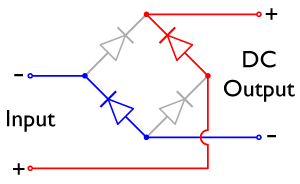| Revision as of 03:58, 4 August 2005 editOmegatron (talk | contribs)Administrators35,798 editsm Capitalization← Previous edit | Revision as of 03:59, 4 August 2005 edit undoOmegatron (talk | contribs)Administrators35,798 editsm CapitalizationNext edit → | ||
| Line 21: | Line 21: | ||
| Prior to availability of integrated electronics, such a bridge rectifier was always constructed from discrete components. Since about 1950, a single four-terminal component containing the four diodes connected in the bridge configuration became a standard commercial component and is now available with various voltage and current ratings. | Prior to availability of integrated electronics, such a bridge rectifier was always constructed from discrete components. Since about 1950, a single four-terminal component containing the four diodes connected in the bridge configuration became a standard commercial component and is now available with various voltage and current ratings. | ||
| == Output |
== Output smoothing == | ||
| For many applications, especially with single phase AC where the full-wave bridge serves to convert an AC input into a DC output, the addition | For many applications, especially with single phase AC where the full-wave bridge serves to convert an AC input into a DC output, the addition | ||
| of a ] may be important because the bridge alone supplies an output voltage of fixed polarity but pulsating magnitude (see photograph above). | of a ] may be important because the bridge alone supplies an output voltage of fixed polarity but pulsating magnitude (see photograph above). | ||
Revision as of 03:59, 4 August 2005
A diode bridge is an arrangement of four diodes connected in a bridge circuit as shown below, that provides the same polarity of output voltage for any polarity of the input voltage. When used in its most common application, for conversion of alternating current (AC) input into direct current (DC) output, it is known as a bridge rectifier. The diagram describes a diode-bridge design known as a full-wave rectifier or Graetz circuit. This design can be used to rectify single phase AC when no transformer center tap is available.
The essential feature of this arrangement is that for both polarities of the voltage at the bridge input, the polarity of the output is constant.
How a diode bridge rectifies
When the input connected at the left hand corner of the diamond is positive with respect to the one connected at the right hand corner, current flows to the right along the upper colored path to the output, and returns to the input supply via the lower one.
When the right hand corner is positive relative to the left hand corner, current flows along the upper colored path and returns to the supply via the lower colored path.
In each case, the upper right output remains positive with respect to the lower right one. Since this is true whether the input is AC or DC, this circuit not only produces DC power when supplied with AC power: it also can provide what is sometimes called "reverse polarity protection". That is, it permits normal functioning when batteries are installed backwards or DC input-power supply wiring "has its wires crossed" (and protects the circuitry it powers against damage that might occur without this circuit in place).
Prior to availability of integrated electronics, such a bridge rectifier was always constructed from discrete components. Since about 1950, a single four-terminal component containing the four diodes connected in the bridge configuration became a standard commercial component and is now available with various voltage and current ratings.
Output smoothing
For many applications, especially with single phase AC where the full-wave bridge serves to convert an AC input into a DC output, the addition of a capacitor may be important because the bridge alone supplies an output voltage of fixed polarity but pulsating magnitude (see photograph above).
The function of this capacitor, known as a 'smoothing capacitor' is to lessen the variation in (or 'smooth') the raw output voltage waveform from the bridge. One explanation of 'smoothing' is that the capacitor provides a low impedance path to the AC component of the output, reducing the AC voltage across, and AC current through, the resistive load. In less technical terms, any drop in the output voltage and current of the bridge tends to be cancelled by loss of charge in the capacitor. This charge flows out as additional current through the load. Thus the change of load current and voltage is reduced relative to what would occur without the capacitor. Increases of voltage correspondingly store excess charge in the capacitor, thus moderating the change in output voltage / current.
Polyphase diode bridges
Diode bridges to deal with polyphase AC inputs have been developed.For instance, for three-phase AC, a full wave bridge rectifier consists of six diodes.




